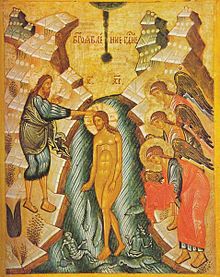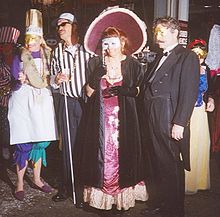Twelve Days of ChristmasFrom Wikipedia, the free encyclopediaJump to: navigation, search
12 Days of Christmas

The Adoration of the Magi. Fresco in Lower Church, Basilica of San Francesco d'Assisi
Observed by Christians
Type Christian
Date December 25–January 5
Observances varies by culture, country
Related to Christmas Day, Twelfth Night, Epiphany
The Twelve Days of Christmas are the festive days beginning Christmas Day (25 December). This period is also known as Christmastide. The Twelfth Day of Christmas is 5 January,[1] with the celebrations of Christmas traditionally ending on Twelfth Night and is followed by the Feast of the Epiphany on 6 January. In some traditions the first day of Epiphany and the twelfth day of Christmas overlap.
Over the centuries, differing churches and sects of Christianity have changed the actual traditions, time frame and their interpretations. St. Stephen's Day (or Boxing Day), for example, is 26 December in the Western Church and 27 December in the Eastern Church. Boxing Day, the first weekday after Christmas, is observed as a legal holiday in parts of the Commonwealth of Nations and was traditionally marked by the giving of Christmas boxes to service workers (such as postal workers and trades people) in the United Kingdom; 28 December is Childermas or the Feast of the Innocents. Currently, the twelve days and nights are celebrated in widely varying ways around the world. For example, some give gifts only on Christmas Night, some only on Twelfth Night and some each of the twelve nights.
Eastern Christianity
In Eastern Christianity (the Eastern Orthodox, Oriental Orthodox and Eastern Catholic churches) the Great Feast of Theophany (Epiphany) on 6 January is considered a higher-ranked feast than the Nativity (Christmas), and commemorates the Baptism of Jesus rather than the arrival of the Wise Men. The twelve days beginning on 25 December are observed as a fast-free period of celebration. The Armenian Apostolic Church and the Armenian Catholic Church, however, observe the Nativity of Christ on 6 January, and thus do not have a twelve day period between Christmas and 5 January.
Orthodox Churches

Icon of the Nativity of Christ.In the Eastern Orthodox Church, The Great Feast of the Nativity of our Lord begins on the Eve of 25 December (for those Orthodox churches which follow the Julian Calendar, 25 December falls on 7 January of the modern Gregorian Calendar).
The Twelve Days of Christmas are a festive period linking together two Great Feasts of the Lord: Nativity and Theophany. During this period one celebration leads into another. The Nativity of Christ is a three day celebration: the formal title of the first day is "The Nativity According to the Flesh of our Lord, God and Saviour Jesus Christ", and celebrates not only the Nativity of Jesus, but also the Adoration of the Shepherds of Bethlehem and the arrival of the Maji; the second day is referred to as the "Synaxis of the Theotokos", and commemorates the role of the Virgin Mary in the Incarnation; the third day is known as the "Third Day of the Nativity", and is also the feast day of the Protodeacon and Protomartyr Saint Stephen.
29 December is the Orthodox Feast of the Holy Innocents.
The Afterfeast of the Nativity (similar to the Western octave) continues until 31 December (that day is known as the Apodosis or "leave-taking" of the Nativity).
The Saturday following the Nativity is commemorated by special readings from the Epistle (1 Tim 6:11-16) and Gospel (Matt 12:15-21) during the Divine Liturgy. The Sunday after Nativity has its own liturgical commemoration in honour of "The Righteous Ones: Joseph the Betrothed, David the King and James the Brother of the Lord".

Russian icon of the Theophany.
1 January, at the center of the festal period, is another feast of the Lord (though not ranked as a Great Feast): the Feast of the Circumcision of the Lord. On this same day is the feast day of Saint Basil the Great, and so the service celebrated on that day is the Divine Liturgy of Saint Basil.
2 January begins the Forefeast of the Theophany.
The Eve of the Theophany (5 January) is a day of strict fasting, on which the devout will not eat anything until the first star is seen at night. This day is known as Paramony ("preparation"), and follows the same general outline as Christmas Eve. That morning is the celebration of the Royal Hours and then the Divine Liturgy of Saint Basil combined with Vespers, at the conclusion of which is celebrated the Great Blessing of Waters, in commemoration of the Baptism of Jesus in the Jordan River. There are certain parallels between the hymns chanted on Paramony and those of Good Friday, to show that, according to Orthodox theology, the steps that Jesus took into the Jordan River were the first steps on the way to the Cross. That night the All-Night Vigil is served for the Feast of the Theophany.
Western Christianity
Middle AgesIn England in the Middle Ages, this period was one of continuous feasting and merrymaking, which climaxed on Twelfth Night, the traditional end of the Christmas season. In Tudor England, Twelfth Night itself was forever solidified in popular culture when William Shakespeare used it as the setting for one of his most famous stage plays, titled Twelfth Night. Often a Lord of Misrule was chosen to lead the Christmas revels.[2]
Some of these traditions were adapted from the older pagan customs, including the Roman Saturnalia and the Germanic Yuletide.[3] Some also have an echo in modern day pantomime where traditionally authority is mocked and the principal male lead is played by a woman, while the leading older female character, or 'Dame', is played by a man.
Colonial America This section does not cite any references or sources.
The early North American colonists brought their version of the Twelve Days over from England, and adapted them to their new country, adding their own variations over the years. For example, the modern day Christmas wreath may have originated with these colonials.[4][5] A homemade wreath would be fashioned from local greenery and if fruits were available, they were added. Making the wreaths was one of the traditions of Christmas Eve; they would be hung on each home's front door beginning on Christmas Night (1st night of Christmas) through Twelfth Night or Epiphany morning. As was already the tradition in their native England, all decorations would be taken down by Epiphany morning and the remainder of the edibles would be consumed. A special cake, the king cake, was also baked then for Epiphany.
Modern Western secular customs
United Kingdom and Commonwealth This section does not cite any references or sources.
Many in the United Kingdom and other Commonwealth nations still celebrate some aspects of the Twelve Days of Christmas. Boxing Day (26 December) is a national holiday in many Commonwealth nations, being the first full day of Christmas. Victorian era stories by Charles Dickens (and others), particularly A Christmas Carol, hold key elements of the celebrations such as the consumption of plum pudding, roasted goose and wassail. While these foods are consumed more at the beginning of the Twelve Days in the UK, some dine and dance in the traditional way throughout, all the way to Twelfth Night.
Nowadays, the Twelfth Day is the last day for decorations to be taken down, and it is held to be bad luck to take decorations down after this date. This is in contrast to the custom in Elizabethan England, when decorations were left up until Candlemas; this is still done in some other Western European countries such as Germany.
United StatesWith the onset of more Americanized and secular traditions throughout the past two centuries (such as the American "Santa Claus"), the rise in popularity of Christmas Eve itself as a holiday, and of New Year's Eve parties, the traditions of the Twelve Days of Christmas have been largely forgotten in the U.S. This is also heightened by the commercial practice to have after-Christmas sales begin on 26 December and run usually until New Year's Eve. Indeed, contemporary marketing and media tend to espouse the (erroneous) belief that the Twelve Days end on Christmas and thus begin 14 December.[6][7]
However, a small percentage of Christians of many sects have held on to their own favorite ways to celebrate and those who choose to also have their own church to guide them in a spiritual way of marking this holiday. Americans who celebrate in various ways include Christians of all backgrounds: Catholics, Orthodox Christians, Lutherans, Episcopalians, Presbyterians, Moravians and those of the Amish and Mennonite communities.

Twelfth Night costumers in New Orleans.
Today, some celebrants give gifts each of the Twelve Days, feast and otherwise celebrate the entire time through to Epiphany morning. Lighting a candle for each day has become a modern tradition in the U.S. and of course, singing the appropriate verses of the famous song each day is also an important and fun part of the American celebrations.
Some still celebrate Twelfth Night as the biggest night for parties and gift-giving and some also light a Yule Log on the first night (Christmas) and let it burn some each of the twelve nights. Some Americans also have their own traditional foods to serve each night.
As in olden days, Twelfth Night to Epiphany morning is then the traditional time to take down the Christmas tree and decorations.
References
1.^ "The Twelve Days of Christmas". http://www.crivoice.org/cy12days.html.
2.^ Frazer, James (1922). The Golden Bough. New York: McMillan. ISBN 1-58734-083-6. Bartleby.com
3.^ Count, Earl (1997). 4,000 Years of Christmas. Ulysses Press. ISBN 1569750874.
4.^ New York Times, 27 December, 1852: a report of holiday events mentions 'a splendid wreath' as being among the prizes won.
5.^ In 1953 a correspondence in the letter pages of The Times discussed whether Christmas wreaths were an alien importation or a version of the native evergreen 'bunch'/'bough'/'garland'/'wassail bush' traditionally displayed in England at Christmas. One correspondent described those she had seen placed on doors in country districts as either a plain bunch, a shape like a torque or open circle, and occasionally a more elaborate shape like a bell or interlaced circles. She felt the use of the words 'Christmas wreath' had 'funereal associations' for English people who would prefer to describe it as a 'garland'. An advertisement in The Times of Friday, December 26, 1862; pg. 1; Issue 24439; col A, however refers to an entertainment at Crystal Palace featuring 'Extraordinary decorations, wreaths of evergreens...', and in 1896 the special Christmas edition of The Girl's Own Paper was titled 'Our Christmas Wreath':The Times Saturday, Dec 19, 1896; pg. 4; Issue 35078; col C. There is though a custom of decorating graves at Christmas with sombre wreaths of evergreen which is still observed in parts of England, and this may have militated against the circle being the accepted shape for door decorations until the re-establishment of the tradition from America in the mid-to-late 20th century.
6.^ Jami Delgado, ehow.com ("Consider being non-traditional and celebrating the Twelve Days of Christmas on the days leading up to Christmas (14 December-25 December)."
7.^ HumorMatters.com Twelve Days of Christmas (reprint of a magazine article); accessed 2008.12.09.
Holidays portal
"Christmas". Catholic Encyclopedia. http://www.newadvent.org/cathen/03724b.htm. Retrieved 22 December 2005. Primarily subhead Popular Merrymaking under Liturgy and Custom.
Bowler, Gerald (2000). The World Encyclopedia of Christmas. Toronto: M&S. ISBN 9780771015311. OCLC 44154451.
Caulkins, Mary (2002). Christmas Trivia: 200 Fun & Fascinating Facts About Christmas. New York: Gramercy. ISBN 9780517220702. OCLC 49627774.
Collins, Ace; Clint Hansen (2003). Stories Behind the Great Traditions of Christmas. Grand Rapids, Michigan: Zondervan. ISBN 9780310248804. OCLC 52311813.
Evans, Martin Marix (2002). The Twelve Days of Christmas. White Plains, New York: Peter Pauper Press. ISBN 9780880887762. OCLC 57044650.
Wells, Robin Headlam (2005). Shakespeare's Humanism. Cambridge: Cambridge University Press. ISBN 9780521824385. OCLC 62132881.
Hoh, John L., Jr. (2001). The Twelve Days of Christmas: A Carol Catechism. Vancouver: Suite 101 eBooks.

No comments:
Post a Comment